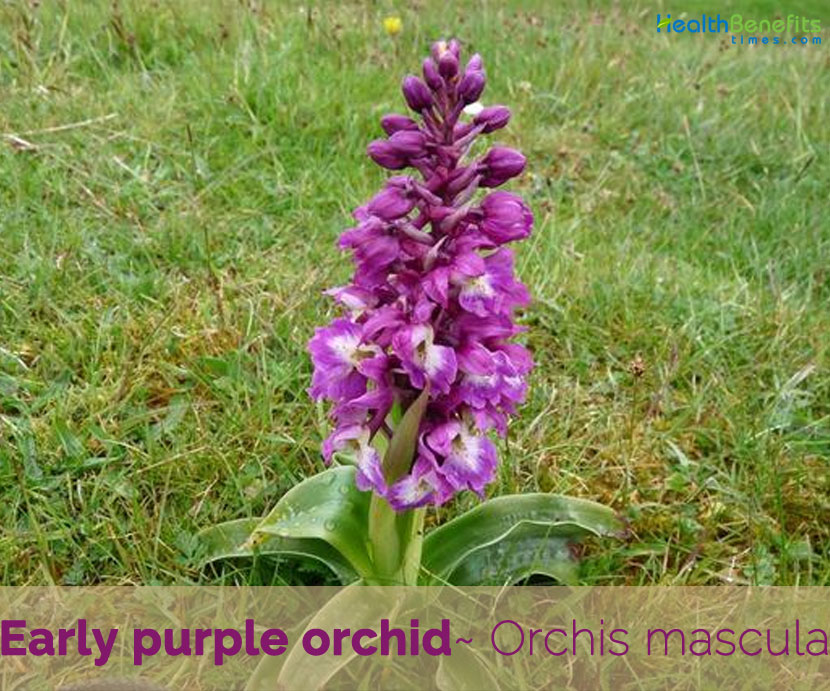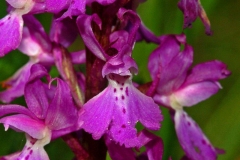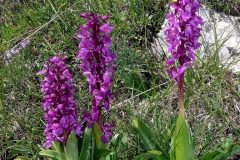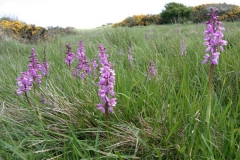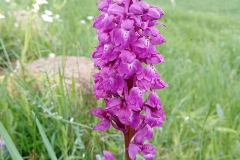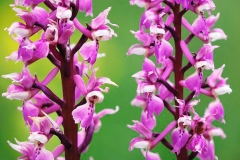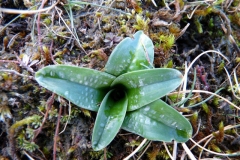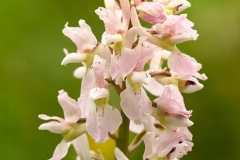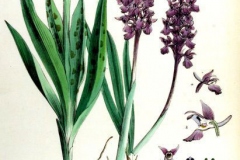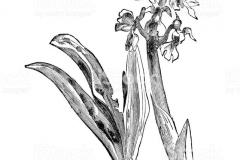| Early purple orchid Quick Facts | |
|---|---|
| Name: | Early purple orchid |
| Scientific Name: | Orchis mascula |
| Origin | Europe including the British Isles, North-West Africa, the Middle East and western and northern Asia |
| Shapes | Capsule |
| Taste | Sweet |
| Health benefits | Beneficial for treat irritations of the gastro-intestinal canal, inflammation of the Gum and Teeth, cure Erectile Dysfunction and Nightfall. fractured Bones, treat Oligospermia and Oligozoospermia, treats stress and mental disorders |
| Name | Early purple orchid |
|---|---|
| Scientific Name | Orchis mascula |
| Native | Europe including the British Isles, North-West Africa, the Middle East and western and northern Asia |
| Common Names | Early Purple Orchid, salep, blue butcher, clue butcher orchid, male orchid, Salep Orchid, Dead Mans Fingers |
| Name in Other Languages | Albanian: Salep Arabic: Sahalab dhikri (سحلب ذكري) Azerbaijani: Erkək səhləb Bokmal: Vårmarihånd Bulgarian: Mŭzhki salep (мъжки салеп) Catalan: Botonets de gos, Botons de ca, Botons de gos, Lliri de prat, Orquis mascle, Orquídia mascle, satírion tacat Corsican: Orchidea maschili Croatian: Muški kaćun Czech: Vstavač mužský Danish: Tyndakset Gøgeurt De Ch: Männliches Knabenkraut Dutch: Mannetjesorchis, Mannetjeorchis English: Early Purple Orchid, salep, blue butcher, clue butcher orchid, male orchid, Salep Orchid, Dead Mans Fingers, Male Orchis Estonian: Jumalakäpp Finnish: Miehenkämmekkä French: Orchis male, Satyrion male, couillon de chien, mâle fou, pain de couleuvre, pentecôte, satirion, satirion male, soupe à vin German: Männliches Knabenkraut, kleines Knabenkraut, Kuckucksknabenkraut, männliche Orchis, männlicher Harlekin, stattliche Orchis, stattliches Knabenkraut Greek: Órchis i árrin (Όρχις η άρρην) Hindi: Salampanja, salab punja root Hungarian: Füles kosbor Irish: Magairlín meidhreach Italian: Orchidea maschio, giglio caprino, orchide maschia Latvian: Vīru dzegužpuķe Lithuanian: Vyriškoji gegužraibė, Vyriskoji geguzraibe Norwegian: Vårmarihand Persian: Thaealib nar (ثعلب نر) Polish: Storczyk męski Portuguese: Satirião-macho, escroto-canino, pata-de-lobo, salepeira-maior, salepo-maior, satirião-macho Russian: Yatryshnik muzhskoy (Ятрышник мужской) Sanskrit: Salabmisri Serbian: Salep (Салеп) Slovak: Vstavač mužský Slovenian: Stasita kukavica Spanish: Campanos, cañamón, chupaeros, civiles, clavellina, compañón de perro hembra, compañón de perro macho, compañón, lirios, orchismacho, orquídea macho, orquídea Silvestre, sangre de Cristo, satirón, satírion macho, satírion manchado Swedish: Sankt Pers nycklar, Sankt pers nycklar, Miehenkämmekkä, Sankt Pers nyckelblomster Turkish: Er salebi Ukrainian: Zozulynetsʹ cholovichyy (Зозулинець чоловічий), zozulinieć vańkova (зозулинець ванькова) Welsh: Tegeirian coch y gwanwyn |
| Plant Growth Habit | Perennial herbaceous plant |
| Growing Climates | Woodland, copses, open pastures in base rich soils, meadows, mountain pastures, woods, coppices, hedgerows |
| Soil | Succeeds in most soils, but it prefers a moist loam and lots of leaf mould. Requires a deep rich soil |
| Plant Size | 25–40 cm (10–16 in.) |
| Root | Root system consists of two tubers, rounded or ellipsoid |
| Stem | Stems are green at the base and purple on the apex |
| Leaf | 3–4 stalkless leaves at base like rosette and alternate sheathing leaves on stem. Blade elliptic–lanceolate–linear, with entire margin, upper surface dark green–greyish green, without spots–spotted, spots often large |
| Flowering season | Mid-April to mid-June |
| Flower | Flower size is about 2.5 centimeters (1 in) and the color varies from pinkish-purple to purple. The lateral sepals are ovate-lanceolate and erect, the median one, together with the petals, is smaller and cover the gynostegium |
| Fruit Shape & Size | Capsule, that contains tiny like dust seeds |
| Flavor/Aroma | Fairly pleasant odor from a distance, but an unpleasant fur-like smell near |
| Available Forms | Infusion, expressed juice, seeds dried |
| Plant parts Used | Tubers, root |
| Taste | Sweet |
| Culinary Uses |
|
| Other facts |
|
Flowers & Fruits
The inflorescence is 7.5–12.5 centimetres (3–5 in) long and it is composed of 6 to 20 flowers gathered in dense cylindrical spikes. The flower size is about 2.5 centimetres (1 in) and the color varies from pinkish-purple to purple. The lateral sepals are ovate-lanceolate and erect, the median one, together with the petals, is smaller and cover the gynostegium. The labellum is three-lobed and convex, with crenulated margins and the basal part clearer and dotted with purple-brown spots. The spur is cylindrical or clavate, horizontal or ascending. The gynostegium is short, with reddish-green anthers. It blooms from mid-April to mid-June. Fertile flowers are followed by capsule that consists of tiny, like dust seeds.
Traditional uses and benefits of Early Purple Orchid
- It is very nutritive, astringent, expectorant and demulcent.
- It has been used as a diet of special value for children and convalescents, being boiled with water, flavored and prepared in the same way as arrowroot.
- Rich in mucilage, it forms a soothing and demulcent jelly that is used in the treatment of irritations of the gastro-intestinal canal.
- Juice extracted from stem of the plant treats inflammation of the gum and teeth.
- Juice heals cuts, wounds and ulcers.
- Root paste of Marsh Orchid is applied as poultice on wounds and cuts.
- Extract treats Intestinal Disorder.
- Oil is applied topically on the penile tissue for curing erectile dysfunction and nightfall.
- Herb is used for treating fractured Bones.
- It promotes the formation of tissues resulting in increased muscle mass. It increases body weight and promotes strength.
- Traditionally, it is used to treat low libido, infertility and nightfall in men.
- It stimulates the physical performance in men. It enhances the stamina, strength and sex drive in men.
- It increases the flow of blood into the Penis. It also allows longer erection in men.
- It is also used to treat Oligospermia (low sperm count) and Oligozoospermia (lack of sperm motility).
- It boosts and maintains the testosterone level in the blood. It increases the sperm count and improves the quality and motility of sperms.
- It treats gastritis and hyperacidity. Marsh Orchid helps to repairs damaged mucosa of the stomach.
- As an aphrodisiac, it is beneficial in treating male sexual disorders like erectile dysfunction and impotence.
Ayurvedic Health benefits
Libido Loss Male: Take 5 tablespoons Withania Somnifera,5 tablespoons Asparagus Racemosus, 1.5 tablespoons Dodder, 2 pinches Saffron, 1 tablespoon Anacyclus Pyrethrum, 1 tablespoon Nutmeg and 1/2 tablespoon Marsh Orchid. Grind all ingredients together. Have half teaspoon with milk daily.
References:
https://pfaf.org/user/Plant.aspx?LatinName=Orchis+mascula
http://www.floracatalana.net/orchis-mascula-l-l-
https://en.wikipedia.org/wiki/Orchis_mascula
http://tn-grin.nat.tn/gringlobal/taxonomydetail.aspx?id=25895
http://www.theplantlist.org/tpl1.1/record/kew-142857
https://gd.eppo.int/taxon/ORSMA


